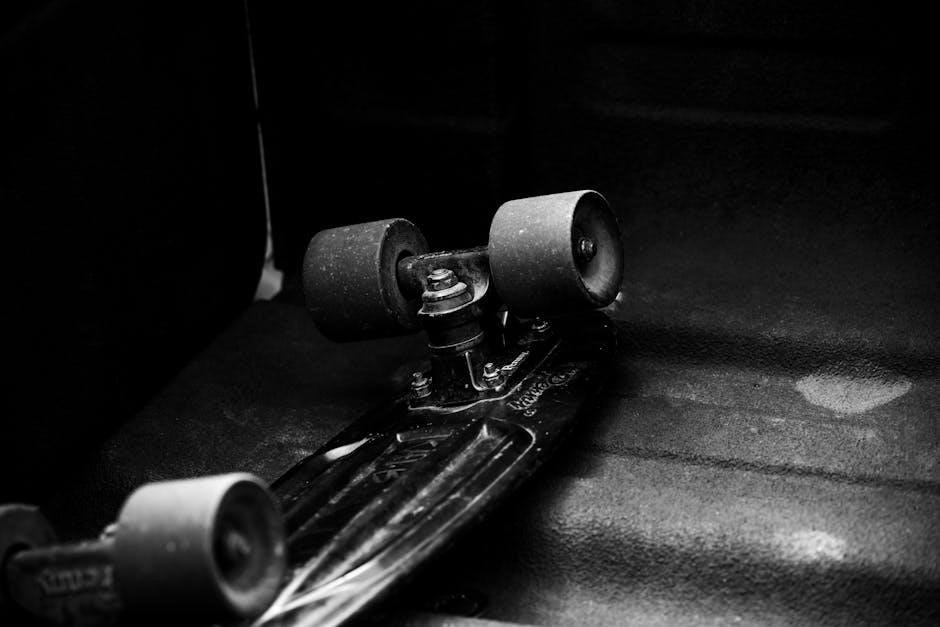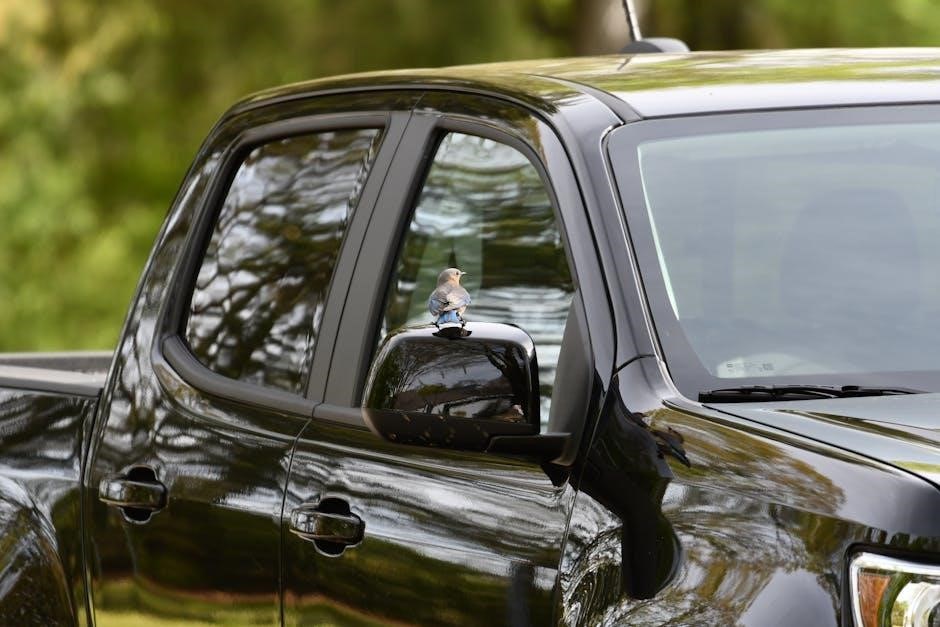Choosing the right skate truck size is essential for optimal performance and comfort. This guide explores deck width, skating style, and personal goals to help you select the perfect trucks.
Understanding the Importance of Skate Truck Size
Skate truck size plays a crucial role in determining performance, stability, and maneuverability. Properly sized trucks ensure optimal compatibility with your deck width, skating style, and personal preferences. They directly impact how your board turns, balances, and responds to movements. Incorrect truck size can lead to poor performance, reduced control, and discomfort while skating. For street skating, smaller trucks offer agility, while larger ones suit cruising and longboarding. Wheel size and hardness also depend on truck size for ideal functionality. Understanding truck size ensures a smoother ride, better tricks, and enhanced overall skating experience, making it a fundamental aspect of customizing your skateboard setup.

What Are Skate Trucks?
Skate trucks are T-shaped metal components that attach to the deck, holding the wheels and axles. They enable turning and stability, made from durable materials like aluminum or steel.
Definition and Function of Skate Trucks
Skate trucks are T-shaped metal components mounted beneath the skateboard deck, serving as the axle and suspension system. They consist of a baseplate, hanger, and kingpin. The baseplate attaches to the deck, while the hanger holds the axle and wheels. Skate trucks allow for turning by pivoting on the kingpin, enabling riders to maneuver. Properly sized trucks ensure better control, stability, and performance, making them crucial for skating style and deck compatibility. The design and material of trucks influence durability and responsiveness, with most made from aluminum or steel for strength and weight efficiency. Understanding their function helps in selecting the right size for optimal skating experience.

Key Factors in Choosing the Right Skate Truck Size
Deck width, skating style, wheel size, and personal goals are critical factors in selecting skate trucks. Proper size ensures stability, control, and optimal performance for various skating needs.
Deck Width and Truck Compatibility
Deck width is a crucial factor in determining the right truck size. The width of the skateboard deck must align with the truck’s axle width for proper fit and function. Trucks that are too narrow or too wide for the deck can lead to instability and poor performance. Most skateboard decks have standard widths, ranging from 7 to 10 inches, which correspond to specific truck sizes. Ensuring compatibility between the deck and trucks is essential for maintaining balance, maneuverability, and overall skating efficiency. Always check the manufacturer’s sizing chart to match your deck width with the appropriate truck size for optimal skating experience. This ensures that your setup is both responsive and durable, allowing you to skate with confidence and control. Additionally, proper alignment prevents uneven wear on the deck and trucks, extending the lifespan of your skateboard. By selecting trucks that are compatible with your deck width, you can enjoy a smoother ride and better handling, whether you’re cruising, carving, or performing tricks. This foundational compatibility is the first step in creating a skateboard that truly meets your skating needs and preferences.
Skating Style and Preferences
Your skating style significantly influences the choice of truck size. Street skaters often prefer narrower trucks for agility and quick turns, while cruisers and longboarders opt for wider trucks for stability. If you’re into tricks and technical skating, a more responsive truck setup is ideal. Conversely, those prioritizing comfort and smooth rides may prefer softer bushings and wider trucks. Personal preferences, such as how tight or loose the trucks feel, also play a role. Softer wheels, for instance, provide better grip and a smoother ride, which is essential for cruising on uneven terrain. Harder wheels, favored by dancers and sliders, offer more precision and slide. Matching your truck size to your skating style ensures a more enjoyable and tailored experience, allowing you to perform at your best. This customization is key to enhancing your overall skating performance and satisfaction.
Wheel Size and Hardness
Wheel size and hardness are critical factors when selecting skate trucks. Larger wheels require wider trucks for stability, while smaller wheels pair better with narrower trucks for agility. Softer wheels (lower durometer rating) provide more grip and a smoother ride, ideal for cruising on uneven surfaces. Harder wheels (higher durometer) offer less grip but more slide, making them suitable for tricks and dancing. Compatibility between wheel size and truck width ensures proper clearance and prevents wheel bite. Additionally, the truck’s bushing hardness should align with your skating style—softer bushings for carving and cruising, and harder ones for precision and stability. Balancing these elements ensures optimal performance and comfort, tailored to your skating needs and preferences. This harmony between wheels and trucks enhances your overall skating experience. Always consider these factors to achieve the best results. Skate smarter, not harder.
Personal Skateboarding Goals
Your personal skateboarding goals play a significant role in choosing the right truck size. If you’re focusing on street skating, smaller trucks (145-149mm) are ideal for tight maneuvers and tricks. For cruising or longboarding, wider trucks (150mm and above) provide stability and control at higher speeds. Additionally, your skill level and preferred terrain should influence your decision. Beginners may benefit from wider trucks for balance, while experienced skaters might prefer narrower trucks for precision. Consider whether you prioritize agility, speed, or comfort, as these factors will guide your truck size selection. Aligning your truck choice with your goals ensures a more enjoyable and efficient skating experience, helping you progress and achieve your objectives. Personalizing your setup is key to unlocking your full potential.

How to Measure Skate Trucks
Skate trucks are measured by their axle width, typically ranging from 125mm to 150mm. Proper measurement ensures compatibility with your deck and optimal performance.
Understanding Truck Measurements and Dimensions
Skate truck measurements are crucial for compatibility and performance. Trucks are typically measured by their axle width, which ranges from 125mm to 150mm, matching deck widths for stability. The hanger, the T-shaped part, and the axle, the metal rod, are key components. The width of the hanger affects how the truck turns, while the axle length impacts stability. Proper measurement ensures the trucks align with the deck’s width, optimizing maneuverability and control. Measuring accurately prevents issues like poor fit or uneven grinding. Always refer to manufacturer guidelines for precise specs tailored to your skating style and deck setup, ensuring a smooth and responsive ride.

Choosing the Right Truck for Your Skating Style
Your skating style dictates the ideal truck size and type. Street skating requires narrower trucks for agility, while cruising needs wider ones for stability and comfort.
Street Skating and Truck Size Recommendations
For street skating, narrower trucks are ideal, typically ranging from 125 to 150mm in axle width. These sizes provide better maneuverability and flip potential. Match your truck size to your deck width for optimal performance. Narrower decks (7-7.5 inches) pair well with 125-129mm trucks, while wider decks (7.5-8 inches) suit 139-149mm trucks. Softer wheels (95A-101A) are preferred for street skating to ensure better grip and smoother landings. Harder wheels, however, offer more slide for advanced tricks. Proper truck size ensures better board control, making it easier to perform ollies, kickflips, and grinds. Always consider your skating style and deck width when selecting trucks for street skating to enhance your overall performance and comfort.
Cruising and Longboarding Truck Size Guide
For cruising and longboarding, wider trucks are recommended, typically ranging from 150mm to 180mm in axle width. These sizes provide greater stability and control at higher speeds. Softer wheels (78A-87A) are ideal for cruising, offering better grip and a smoother ride on various surfaces. Harder wheels are less common in this style but can be used for specific terrain. Match your truck size to your deck width for optimal performance. Narrower decks (7-8 inches) pair well with 150-160mm trucks, while wider decks (8.5-10 inches) suit 170-180mm trucks. Proper truck size ensures better stability and smoother rides, making it easier to carve and maintain momentum; Always consider your deck width and skating style when selecting trucks for cruising and longboarding to enhance your overall experience and comfort.
Truck Size for Different Terrain and Tricks
Truck size plays a crucial role in handling various terrains and tricks. For street skating, narrower trucks (125-150mm) are ideal for tight maneuvers and tricks like grinds and slides. Wider trucks (150-180mm) are better suited for rough terrain, such as uneven sidewalks or transition skating, offering stability and control. Softer wheels (78A-87A) pair well with wider trucks for cruising on rough surfaces, while harder wheels (95A-101A) are preferred for tricks requiring quick slides. When skating bowls or vert ramps, wider trucks (150-180mm) provide the necessary stability for high-speed transitions. Always match your truck size to your skating environment and style to ensure optimal performance and safety. Proper truck size enhances your ability to adapt to different terrains and master various tricks.

Common Mistakes to Avoid
Common mistakes include choosing trucks based solely on aesthetics, ignoring deck width compatibility, and not considering skating style or terrain, leading to poor performance and discomfort.
Choosing the Wrong Truck Size for Your Deck
Choosing the wrong truck size for your deck is a common mistake that can significantly affect performance. Skate trucks must match the width of your skateboard deck for optimal stability and control. A truck that is too wide or too narrow can lead to poor turning ability, uneven weight distribution, and difficulty in performing tricks. Wider decks require wider trucks, while narrower decks need narrower trucks to ensure proper alignment and responsiveness. Misaligned trucks can cause the board to feel unstable, making it harder to maneuver, especially for beginners. Always ensure your truck size aligns with your deck width to maximize your skating experience and avoid potential frustrations.
Ignoring Your Skating Style When Selecting Trucks
Ignoring your skating style when selecting trucks can lead to a mismatch between your needs and the truck’s performance. Different skating styles, such as street, cruising, or longboarding, require specific truck sizes for optimal results. For example, street skaters may prefer wider trucks for stability during tricks, while cruisers might opt for narrower trucks for better maneuverability. Failing to consider your skating style can result in poor turning, difficulty in performing tricks, or an uncomfortable ride. Always align your truck size with your primary skating style to ensure better control, responsiveness, and overall skating satisfaction. Matching your style with the right trucks enhances your performance and enjoyment.
Overlooking Wheel Compatibility
Overlooking wheel compatibility is a common mistake that can significantly affect your skating experience. Skate trucks must be paired with wheels of appropriate size and hardness to ensure proper performance. Mismatched wheels can lead to issues such as wheel bite, poor maneuverability, or uneven wear. Softer wheels, which provide better grip, require trucks with enough space to accommodate their width, while harder wheels, ideal for tricks, need trucks that allow precise control. Neglecting compatibility can result in a less responsive board and a less enjoyable ride. Always consider both wheel size and hardness when selecting trucks to ensure optimal performance and longevity of your setup. Proper alignment enhances your skating experience and prevents potential damage to your board.
Choosing the right skate truck size enhances your skating experience by improving control, stability, and performance. Consider deck width, skating style, and wheel compatibility for the best setup.

Final Tips for Selecting the Perfect Skate Truck Size
When selecting skate trucks, ensure compatibility with your deck width for optimal performance. Consider your skating style—street, cruising, or tricks—and choose trucks that align with these preferences. Wheel size and hardness also play a role; softer wheels offer grip and a smoother ride, while harder wheels are ideal for slides and technical maneuvers. Personal goals, such as learning new tricks or commuting, should influence your decision. Avoid common mistakes like mismatching trucks to your deck or ignoring wheel compatibility. Test different setups if possible, and seek advice from experienced skaters or professionals. By balancing these factors, you’ll find the perfect trucks to elevate your skating experience.
